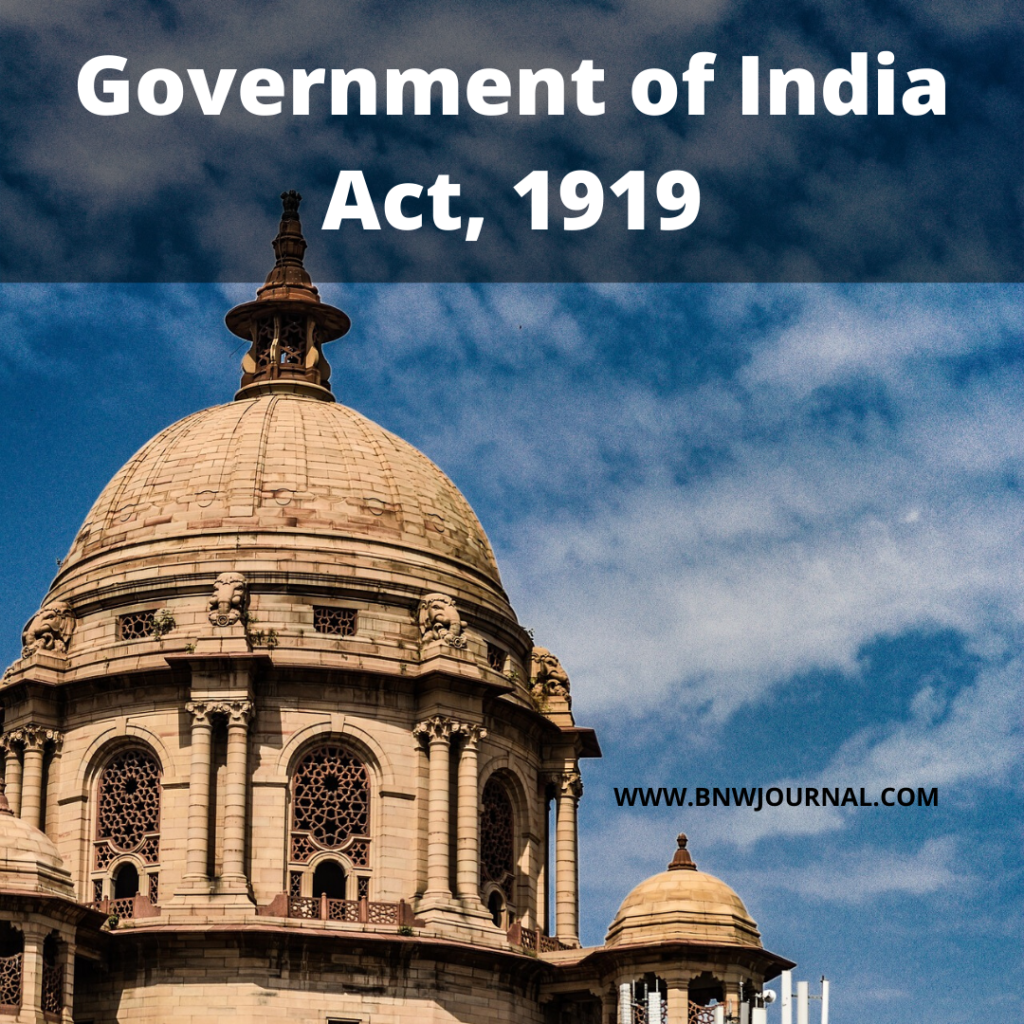![]()
Introduction
The government of India act 1919 was a byproduct of intense nationalist political activity the events during the war and the prevalent sentiments were responsible for the signing of the Lucknow pact between the Congress and the Muslim league the establishment of home rule league and the August declaration and finally to Montague Chelmsford reforms. The Government of India 1919 was nothing more than a codified version of these reforms introduced by Sir Edvin Montague the Secretary of State and Lord Chelmsford the Viceroy of India.
The introduction of the act was ‘progressive realization’ of a government inclusive of Indians, bringing about major administrative changes consisting of 5 Schedules, facilitated by 47 sections. Referred by Dr. Bhimrao Ambedkar as the British Constitution of India this was the first step when India moved towards the idea of self-government.

August Declaration, 1917: Prelude To Government Of India Act 1919
The August declaration 1917 by the secretary of state of India Edvin Montague in lieu of the explosive situation. It creates by the home rule movement. The first conclusive step towards the idea of a written set of rules and regulations. It is through which the multilingual the multilinguistic Society of India would be govern on August 20, 1917.
“The policy of his Majesty’s government with which the government of India is incomplete a called is that of increasing Association of Indians in every branch of administration and a gradual development of self-governing institutions, with a view to the progressive realization of responsible government ship in India as a part of the British Empire”
This statement by Edwin Montague in his official capacity indicates; that in the long run the British would grant self-government to India within the British Empire. However the introduction of the GOI act 1919 was a dichotomy. Between the ideal categories prefix by Britishers i.e. of self-government or occupations of use India. It fit into neither of those hence the independence of India was in a diabolical state
This declaration was proclaime as Magna Carta. However, the assertive nationalists doubted the declaration seeking it as “unworthy and disappointing”. Moreover calling this as unworthy of England to offer and India to accept according to Mrs. Annie Besant. The problems shared by the depress class community. The issue with the Sikh community were the major reasons why the August declaration prove to be a major failure. And force the Viceroy and secretary of state to take drastic measures to resolve the communal harmony which was originally fostered by the Britishers.
Salient features
The main provisions of the government of India act 1919 were the following
I. Central government to be responsible to the British parliament
- The secretary of state for India would control the affairs relating to the government of India
- The central legislature was to consist of two chambers – the council of state and the Indian legislature assembly. The council of state was to consist of 60 members of whom 34 were to be elected. The legislature assembly was to have 144 members of whom 104 were to be elected and the rest were to be nominated. The powers of both the chambers were to be identical except that the power to vote grants were only to be given to the legislative assembly.
- The central legislature was empowered to enact laws on any matter for the whole of India, subject to certain restrictions. It was given power over finance except in certain items of expenditure however the Viceroy had unlimited overriding powers.
- The Governor-general was given the power to summon, prorogue, and all the chambers. His previous sanction was required to introduce some bills.
- The high commission in London could look after the interest of the Indian people
- The control of the Secretary of the state over the affairs of India were reduced
- The number of Indians in Viceroy’s executive council was raised to 3 in a council of 8 though they were given smaller departments.
- The act provided for the establishment for the first time in India of a Public service commission.
II. Provincial Legislative Council
The act provided for the establishment of a legislative council consisting of the members of the executive council as well as of nominated and elected members at least 75% of the members were to be elected and of the nominated members not more than 20% were to be officials. The tenure of the legislative Council was three years.
III. Dual government or a dyarchy in the provinces
The system of dual administration was introduced in the provinces. The subjects to be dealt with by the provincial governments were subdivided into two parts as follows
- Reserved subjects; the reserved subjects such as finance, law and order, irrigation, et cetera were to be administrated by the governor with the help of the executive council nominated by him
- Transferred subjects; the transferred subjects such as education public health agriculture, et cetera while to be administered by the Governor with the help of the council of ministers chosen by him He could overrule the ministers on any ground that he considered special. He also retained complete control over the finances.
IV. Elections
The following provisions were made regarding elections;
- The system of indirect election was replaced by the system of direct election.
- That extended communal franchise to other communities and even the Sikhs, Europeans, and Anglo Indians got separate representation.
Critical approach towards the act
The GUI act 1919 or the Montague-Chelmsford reforms were important in the constitutional history of India. They pointed to words establishing a responsible government in India but the act had some minor but important defects and overall, in the end, it could not come up to the expectation of the Indians
The first major issue was with the system of Diarchy as it had an illogical basis on which the division of subjects was made. For example agriculture was a transferred subject where island revenue and irrigation came under the reserved subjects. Secondly and more importantly the councilors and ministers were divided in their loyalties one set was responsible to foreign government while the other to the Indian electorate the 2/2 to please different masters often clashed with each other
The other most important thing was that the position of ministers was weak they had to serve two masters; governor and the legislative Council. They were not given full control over any subject. A minister was appointed by the governor and dismissed that as well. There was no provision of collective responsibility of the ministers to the provincial legislator effectively making the whole system of the 1919 act inefficient and ineffective. Lastly the financial arrangements were defective as ministers did not have sufficient funds to carry out nation-building activities they had to depend on the finance minister, who is a member of the bureaucracy had little sympathy with the aspirations of the people as represented by the ministers. All these defects alongside the unsatisfied Congress and Muslim league promoted events for the GOI Act 1935 which was essentially to serve as the basis for the Constitution of India.



0 Comments